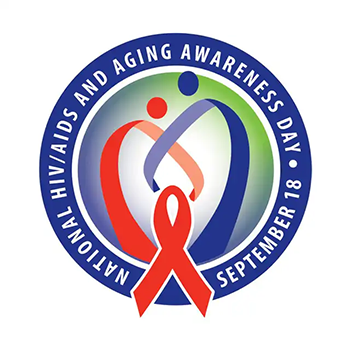National HIV/AIDS and Aging Awareness Day
Protect Our Aging Populations: Meeting New Challenges to Live Longer and Improve Lives!
National HIV/AIDS and Aging Awareness Day (NHAAD) raises awareness about the need for HIV prevention and treatment strategies for older adults and long-term survivors with HIV. First recognized in 2008 by the AIDS Institute, the observance also emphasizes the importance of research to better understand the effects of aging on long-term and lifetime survivors with HIV. This year’s theme, Protect Our Aging Populations: Meeting New Challenges to Live Longer and Improve Lives!, emphasizes the importance of prevention, research, and data in this population and the need to increase understanding of how HIV impacts the aging process.
According to the Centers for Disease Control and Prevention (CDC), more than half of people with HIV in the United States are aged 50 or older. Approximately 16 percent of new HIV diagnoses occurred in this age group in 2023. Not all people who experience aging-related complications of HIV are older adults. The first people who acquired HIV perinatally, or soon after birth, are now in their 30s and early 40s and may experience aging-related conditions at younger ages. According to CDC, there are 13,000 people in the United States who acquired HIV perinatally, also known as lifetime survivors.
People aging with HIV and lifetime survivors can face treatment-related challenges, such as drug interactions between medicines for HIV and other conditions. People with HIV also have a higher probability for aging-related conditions like cardiovascular disease, neurocognitive decline, and aging-related frailty than people without HIV.
Research to identify and address the long-term health needs of people, including lifetime survivors, aging with HIV, across the care continuum is critical to support this growing population. The National Institutes of Health (NIH) supports research to improve understanding of HIV-associated comorbidities, as well as their relationship to aging and HIV.
The NIH Office of AIDS Research (OAR) launched a dedicated program on HIV and Aging in 2022 to meet the increasing public health needs of older adults and lifetime survivors with HIV and to catalyze research at the intersection of HIV and aging. Along with the NIH National Institute on Aging (NIA) and other partners at NIH, OAR brings together NIH, people with HIV, researchers, and relevant U.S. government partners to improve care for people aging with HIV and lifetime survivors.
Social Media
Use the hashtags #HIVandAging to follow the conversation on social media. Download graphics and find sample social media posts on the HIV.gov NHAAD webpage. Social media graphics also are available on The AIDS Institute NHAAD webpage.

Additional Resources
NIH Office of AIDS Research (OAR)
- FY 2021–2025 NIH Strategic Plan for HIV and HIV-Related Research provides a roadmap for NIH to guide HIV and HIV-related research and direct HIV research funding to the highest-priority areas to help end HIV. NIH has several priorities for HIV-related research, including research into complications from long-term HIV disease and long-term use of antiretroviral therapy (ART).
- OAR's dedicated program on HIV and Aging aims to meet the increasing public health needs of older adults and lifetime survivors with HIV and to catalyze research at the intersection of HIV and aging.
- The NIH OAR Data Hub’s HIV and Aging Topical Portfolio Analysis provides information on the number of NIH-funded projects related to HIV and aging; funding amounts; and the NIH Institutes, Centers, and Offices (ICOs) that conduct research on HIV and aging.
- The June 2024 OAR Advisory Council meeting featured prominent discussion of the needs of long-term and lifetime survivors with HIV. Guest speaker Kimberly Canady, a public health educator and consultant, who born with HIV in the 1980s, discussed her experience growing up with HIV before the availability of ART and called on the research community to prioritize research to address the needs of long-term and lifetime survivors with HIV. Read a summary of the meeting, or view Ms. Canady’s presentation on NIH VideoCast, beginning at 1:52.
- This OAR Director’s Blog post describes OAR’s efforts to address the long-term needs of people aging with HIV and provides insights from two 2023 OAR events related to HIV and aging.
- HIVinfo.NIH.gov, maintained by OAR, provides HIV-related infographics, fact sheets, and links to additional resources:
- The HIV and Older People fact sheet provides information on HIV testing, prevention, and treatment in older people, explains age-related factors that may cause complications, and includes links to additional resources.
- The Preventing Perinatal Transmission of HIV fact sheet and Protecting Baby From HIV infographic explain how pregnant people with HIV, which may include lifetime survivors, can prevent perinatal transmission to their infants.
- The Living with HIV and AIDS and Older Adults HIV Source collections provide resources from federal and nonfederal sources on topics like housing, mental health, and how to stay healthy with HIV.
HIV.gov
HIV.gov provides information on the U.S. government’s HIV response and aims to expand visibility of relevant federal HIV policies, programs, and resources and to increase knowledge about HIV and access to HIV services. Learn more on the HIV.gov Aging with HIV webpage. In addition, the NHAAD webpage provides information about HIV testing and prevention.
